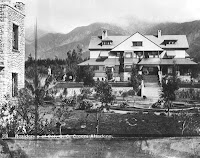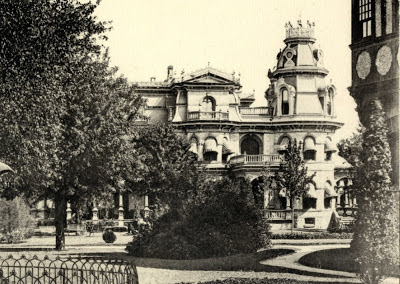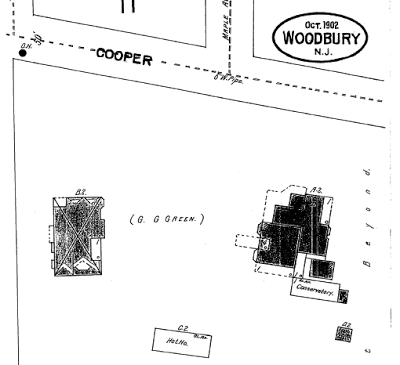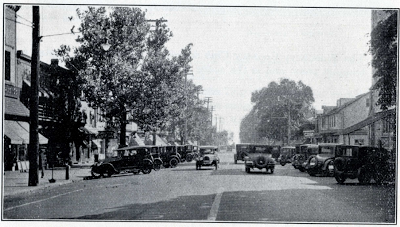Wednesday, December 26, 2012
Broad St. Looking South
Here's a nice grouping of various Broad St. photos I've come across, taken from roughly the same vantage point over the years. Be sure to also check out Broad St. views looking North.
Thursday, December 13, 2012
G. G. Green Avenue: Pennington Seminary
 |
The more I research George Gill Green, the multi-millionaire from Woodbury, New Jersey, the more I am amazed at his wealth and subsequently, his contributions to society. Sometime in the mid 1800s, G.G. attended school at the Pennington Seminary, now known as the Pennington School which is located north of Trenton. While a student there, he founded the Philomathean Society and became their first president. He sat on the Board of Trustees for many years after graduating and once he amassed his fortune, he donated significantly to the school. He donated an entire library to the Philomathean Society, which was then aptly named the George G. Green Library. He and his wife, Angie, also donated a collection of "rare and valuable minerals." Side Note: Frank Moore, a former pastor of Kemble Church in Woodbury, NJ later became president of Pennington in 1905.
His most remarkable contribution to the school and in fact, to the whole town, was in the form of a road that he had constructed which led from the train station right to the steps of the school. It was named G. G. Green Avenue in his honor (see top photo). Judging from Google Maps, the road is still named after him, now called Green Street and Green Avenue. Unfortunately, I feel that many even in Pennington School today have forgotten G. G. Green, whose portrait once hung in the school halls. Much mention of any Green within Pennington School of late is of a Francis Harvey Green who was headmaster sometime in the 1920s. I'm afraid that many assume that Green Street is named for Francis and not George Gill. Unfortunately, I feel this philanthropic multimillionaire from Woodbury, NJ and his many contributions far and wide are largely unremembered today.
Hanlon, T. (1892). Annual cataloge of the pennington seminary and female collegiate institute of the new jersey annual conference. Trenton, NJ: MacCrellish & Quigley. Retrieved from http://books.google.com/books?id=9V09AAAAYAAJ&dq=pennington "g.g. green"&pg=RA2-PA45
Monday, December 10, 2012
Gray Towers: Part Three
Welcome to Part Three of the story of Woodbury's palatial estate, Gray Towers. The ending to this veritable fairy tale is not a happy one. So let us first visit some of the more positive recollections pertaining to G. G. Green and his mansion of blue gray stone that once stood on Cooper Street.
Once upon a time, Green provided jobs to as many as 600 locals between his two glass factories and patent medicine laboratory alone (Pepper, 1971). In 1888, as president of the Board of Trade, Green successfully attempted to invite new industry to Woodbury by convincing Council to waive local taxes for five years for new industries (Woodbury, 1988). The general local impression of the Green family was one of favorable disposition judging from the many editorials published in the Woodbury Daily Times, Woodbury Constitution, and other local newspapers of the time. It was written in 1925 that his "success in business seemed to intensify his desire to advance the interests of the town of his choice. Very few men succeed as Col. Green has succeeded. Few would have remained to live in a town which was at that time only a little country village. But he had a vision of a great future for Woodbury and made that vision practical by casting his lot here permanently." Even down to Green's residence, the palace of Gray Towers itself was viewed as a source of pride to Woodbury and symbolically represented the "result of true merit;" G. G. Green's very words.
Like so many others in his position however, this self-made multimillionaire did not reclusively hideaway in his towering mansion. He contributed generously to the civic well-being of his home town and in addition, served on City Council, was Director of the First National Bank, was vice-president of the Woodbury Country Club, and was a Trustee to his alma mater, the Pennington Seminary, which he donated graciously to in his lifetime. These are just a few of his extracurricular activities. Some of the lighter memories of G. G., which help to paint a vivid picture of this Victorian businessman include his generous yearly opening of his lushly decorated private railcar to tour, his conservatory of fine plants which was periodically open to the public, and it is often told that he used to bring fresh candied apples down to the children ice skating on his lake. His grounds and lake were open to the public and welcomed. The following is a wonderful description of G. G.'s social impact on Woodbury taken from Carter and Carpenter's History of Woodbury from 1681 to 1936:
Colonel Green’s Tally-ho
Amid all the struggle to develop a growing city there was an occasional flash of color. One was when Dr. Green’s great coach and four, the Tally-ho, with driver on a high seat and horn pealing, drove through the streets and country side, and the other when his nineteen salesmen returned for their yearly conference. On at least one night they were entertained at the home of their employer and always observed the rule to be dressed in swallow tail suits adorned with tall silk hats. And what old resident does not remember Colonel Green’s “palace car” which stood on the siding at the railroad station preceding and following the winter migration of Colonel Green and his family to Pasadena?
Every year, G. G. and family hosted a grand fete champetre at Gray Towers for his employees and their families in honor of their hard work and dedication. Swallowtail suits and high silk hats were de rigueur for the party (Pepper, 1971). The first of these large scale events occurred on September 2nd, 1878 and featured a feast of food, a live band, fireworks over the lake, and what appears to be miniature hot air balloons! The house and grounds were festively decorated with Chinese lanterns, and judging from the illustration that appeared in the New York Daily Graphic paper (see below illustration), it appears to have been an absolutely beautiful affair.At one point, G. G. owned 3 (excluding his other real estate holdings) extravagant residences: Gray Towers, Kil Kare Castle in Lake Hopatcong, NJ, and an Arts and Crafts style mansion in Altadena, CA; a town in which he helped build. However, it was Gray Towers in Woodbury that he truly called home and on February 21st, 1925 G. G. Green joined the heavenly choir and died within his blue stone mansion on Cooper Street. "Unlike many a man of wealth remembered only for profligate eccentricities or penny-pinching exploitation, Green was an innovator who transformed and benefitted communities and industries that came within his orbit." (Pepper, 1971) He was buried at the Eglington Cemetery at nearby Clarksboro, NJ.
 |
| G.G. Green in Gray Towers Woodbury, NJ photo credit: Lake Hopatcong Historical Museum |
 |
| Kil Kare Castle on Mount Harry Lake Hopatcong, NJ |
 |
| G. G. Green Mansion Altadena, CA |
G. G.'s widow, Angie Brown Green remained at the residence until her death in 1934. Afterwards, the mansion remained in the family in an uninhabited state until August 1943 when the St. Patrick's Parish under Rev. James McKeever purchased the building for potential use as a parochial grade school (which became the St. Patrick's School). Adaptive reuse was virtually unheard of in 1943 and we should applaud the parish at that time for an early attempt at reusing a grand Victorian mansion for a use other than what it was designed for. However, the historic preservationist in me can't help but feel shocked at what resulted architecturally in creating a parochial school out of a grand second empire mansion. But let's face it, they purchased a historic building that was not protected during a time when Victorian architecture was viewed as pompous and over-ornate. It seems that the 1940's were hard on Woodbury Victorians as that is when the city also lost the equally magnificent Lewis M. Green mansion (Woodbury's mayor 5 times over) on Broad Street. It wasn't until the 1970's when things nationally began to turn in favor of saving historic buildings and not until the 1980's when the protective historic districts were setup in Woodbury. I might add that still we must see historic structures torn down without much of a fight.
How I wish that someone in the city in 1943 had the forethought to recognize the massive potential for Woodbury in purchasing and restoring Gray Towers as a tourist attraction or museum in honor of the single most important family in Woodbury history, save the Woods themselves.
But that never happened. Instead, the third and fourth story ornate and rare S-curved mansard roof, towers, and wraparound porches were torn off, effectively changing Gray Towers into a gray stone box. Further architecturally bland box additions were added to the building in 1953 and 1961; a classic "remuddling." Mouse over the below image for a dramatic before and after of the West side entry.
 |
| place your mouse over the image above to see the dramatic "remuddling" of the West side of Gray Towers in the 1940s or see below: |
G. G. Green Jr. himself remarked that it was like, "going into another world" and on a return visit, Robert Luba with Blanche and Gay Green remarked that, "The mansion and grounds which were once beautiful are now in terrible shape. It was a shame to see how beautiful they were and how rundown they are now." But at least the core of the building still stood for a time, allowing for a hint at its former glory. That all changed however, on May 21st 1968, when a 3-hour blaze fought by over 100 firefighters left the mansion "in ruins."
 |
| Catholic Star Herald May 31, 1968 |
Gone but not forgotten
The End.
READ Part ONE: HERE
READ Part TWO: HERE
 |
| Carriage House and Coachmen's Residence w/Gray Towers in Background This thankfully still stands and Holy Angels Parish is currently fixing the exterior! |
______________
The below image is a 2012 aerial map image with a 1930 B&W aerial inset of Gray Towers showing approximate location of where the mansion sat. The Gray Towers' stable house (still standing) is shown just left of the inset box, the old Woodbury Station is shown upper left corner at the intersection of Cooper and Railroad.
 |
| 1902 Sanborn map showing carriage house on left and Gray Towers on right. |
__________________________________
Carter, B. F., Carpenter, J. D., & Stewart, F. H. (1938). History of Woodbury, New Jersey, from 1681 to 1936. [Woodbury, N.J.: Gloucester County Pub. Co.]
Col. G. G. Green passes away. (1925, Feb 26). Gloucester county democrat
Green mansion purchased by St. Patrick's parish as site of parochial school. (1943, Sept 9). Gloucester county times
McAlester, V., & McAlester, L. (1984). A field guide to American houses. (p. 251). New York, NY: Knopf.
Pepper, A. (1971). The glass gaffers of New Jersey. (p. 194). New York, NY: Charles Scribner's Sons.
3-hr. blaze damages St. Patrick's school; all classes called off. (1968, May 22). Gloucester county times
Woodbury Multiple Resource Area: Partial Inventory of Historical and Architectural Resources, nomination document, 1988, National Park Service, National Register of Historic Places, Washington, D.C.
Tuesday, December 4, 2012
Preservation Potentials: 55 Newton Avenue
SEPTEMBER 2013 UPDATE: SOLD
Recently listed is an amazingly beautiful gray stone Victorian duplex on a lovely and predominantly period street, Newton Avenue. At $159,000, you can't go wrong.
Subscribe to:
Posts (Atom)





q!BQlv4Bm0wg~~60_57.JPG)






















